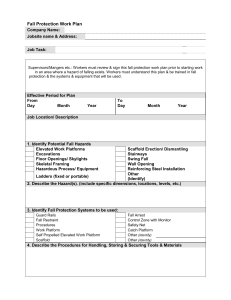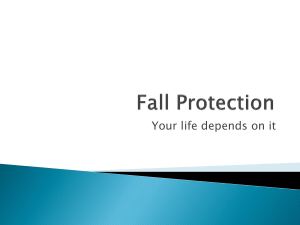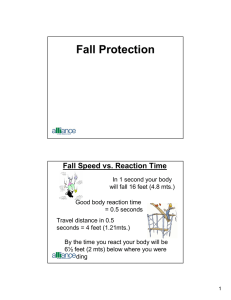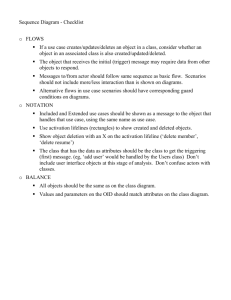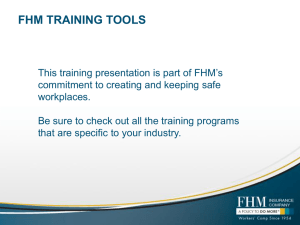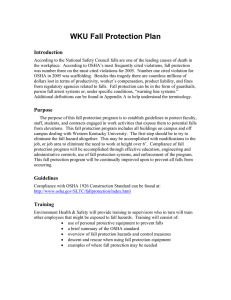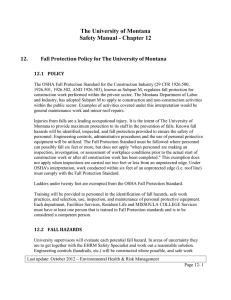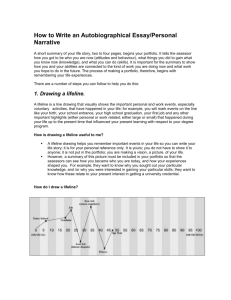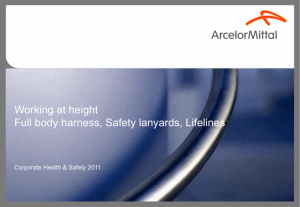Safety Harness & Fall Protection Training | Toolbox Talk
advertisement
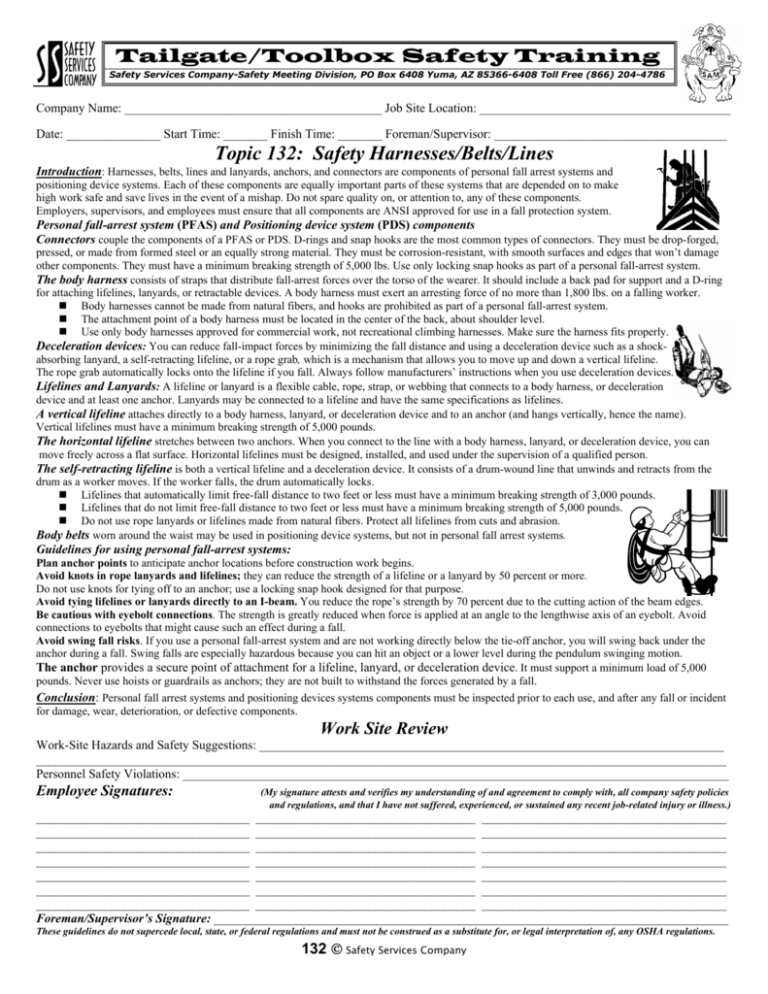
Tailgate/Toolbox Safety Training Safety Services Company-Safety Meeting Division, PO Box 6408 Yuma, AZ 85366-6408 Toll Free (866) 204-4786 Company Name: _________________________________________ Job Site Location: ________________________________________ Date: _______________ Start Time: _______ Finish Time: _______ Foreman/Supervisor: _____________________________________ Topic 132: Safety Harnesses/Belts/Lines Introduction: Harnesses, belts, lines and lanyards, anchors, and connectors are components of personal fall arrest systems and positioning device systems. Each of these components are equally important parts of these systems that are depended on to make high work safe and save lives in the event of a mishap. Do not spare quality on, or attention to, any of these components. Employers, supervisors, and employees must ensure that all components are ANSI approved for use in a fall protection system. Personal fall-arrest system (PFAS) and Positioning device system (PDS) components Connectors couple the components of a PFAS or PDS. D-rings and snap hooks are the most common types of connectors. They must be drop-forged, pressed, or made from formed steel or an equally strong material. They must be corrosion-resistant, with smooth surfaces and edges that won’t damage other components. They must have a minimum breaking strength of 5,000 lbs. Use only locking snap hooks as part of a personal fall-arrest system. The body harness consists of straps that distribute fall-arrest forces over the torso of the wearer. It should include a back pad for support and a D-ring for attaching lifelines, lanyards, or retractable devices. A body harness must exert an arresting force of no more than 1,800 lbs. on a falling worker. Body harnesses cannot be made from natural fibers, and hooks are prohibited as part of a personal fall-arrest system. The attachment point of a body harness must be located in the center of the back, about shoulder level. Use only body harnesses approved for commercial work, not recreational climbing harnesses. Make sure the harness fits properly. Deceleration devices: You can reduce fall-impact forces by minimizing the fall distance and using a deceleration device such as a shockabsorbing lanyard, a self-retracting lifeline, or a rope grab, which is a mechanism that allows you to move up and down a vertical lifeline. The rope grab automatically locks onto the lifeline if you fall. Always follow manufacturers’ instructions when you use deceleration devices. Lifelines and Lanyards: A lifeline or lanyard is a flexible cable, rope, strap, or webbing that connects to a body harness, or deceleration device and at least one anchor. Lanyards may be connected to a lifeline and have the same specifications as lifelines. A vertical lifeline attaches directly to a body harness, lanyard, or deceleration device and to an anchor (and hangs vertically, hence the name). Vertical lifelines must have a minimum breaking strength of 5,000 pounds. The horizontal lifeline stretches between two anchors. When you connect to the line with a body harness, lanyard, or deceleration device, you can move freely across a flat surface. Horizontal lifelines must be designed, installed, and used under the supervision of a qualified person. The self-retracting lifeline is both a vertical lifeline and a deceleration device. It consists of a drum-wound line that unwinds and retracts from the drum as a worker moves. If the worker falls, the drum automatically locks. Lifelines that automatically limit free-fall distance to two feet or less must have a minimum breaking strength of 3,000 pounds. Lifelines that do not limit free-fall distance to two feet or less must have a minimum breaking strength of 5,000 pounds. Do not use rope lanyards or lifelines made from natural fibers. Protect all lifelines from cuts and abrasion. Body belts worn around the waist may be used in positioning device systems, but not in personal fall arrest systems. Guidelines for using personal fall-arrest systems: Plan anchor points to anticipate anchor locations before construction work begins. Avoid knots in rope lanyards and lifelines; they can reduce the strength of a lifeline or a lanyard by 50 percent or more. Do not use knots for tying off to an anchor; use a locking snap hook designed for that purpose. Avoid tying lifelines or lanyards directly to an I-beam. You reduce the rope’s strength by 70 percent due to the cutting action of the beam edges. Be cautious with eyebolt connections. The strength is greatly reduced when force is applied at an angle to the lengthwise axis of an eyebolt. Avoid connections to eyebolts that might cause such an effect during a fall. Avoid swing fall risks. If you use a personal fall-arrest system and are not working directly below the tie-off anchor, you will swing back under the anchor during a fall. Swing falls are especially hazardous because you can hit an object or a lower level during the pendulum swinging motion. The anchor provides a secure point of attachment for a lifeline, lanyard, or deceleration device. It must support a minimum load of 5,000 pounds. Never use hoists or guardrails as anchors; they are not built to withstand the forces generated by a fall. Conclusion: Personal fall arrest systems and positioning devices systems components must be inspected prior to each use, and after any fall or incident for damage, wear, deterioration, or defective components. Work Site Review Work-Site Hazards and Safety Suggestions: __________________________________________________________________________ ______________________________________________________________________________________________________________ Personnel Safety Violations: _______________________________________________________________________________________ Employee Signatures: (My signature attests and verifies my understanding of and agreement to comply with, all company safety policies and regulations, and that I have not suffered, experienced, or sustained any recent job-related injury or illness.) __________________________________ ___________________________________ _______________________________________ __________________________________ ___________________________________ _______________________________________ __________________________________ ___________________________________ _______________________________________ __________________________________ ___________________________________ _______________________________________ __________________________________ ___________________________________ _______________________________________ __________________________________ ___________________________________ _______________________________________ __________________________________ ___________________________________ _______________________________________ Foreman/Supervisor’s Signature: __________________________________________________________________________________ These guidelines do not supercede local, state, or federal regulations and must not be construed as a substitute for, or legal interpretation of, any OSHA regulations. 132 © Safety Services Company
